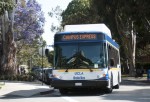UCLA Transportation is currently celebrating 30 years of its sustainable transportation program, although regular commuters said they think even more can be done.
The move to solve UCLA transportation sustainability issues began in 1984, when the Summer Olympics were held in Los Angeles and officials looked for ways to accommodate the influx of people. Since then, UCLA has created programs such as BruinBikes, BruinBus shuttles and the Bruin Commuter Club, among others.
In 1990, UCLA signed the Trip Mitigation and Monitoring Agreement with the City of Los Angeles to reduce traffic in and out of the campus. The percentage of commuters taking private cars was 23 percent higher in 1990 than it is today, said David Karwaski, senior associate director of planning policy and traffic systems for UCLA.
A majority of UCLA students walk, bike or take commuter transit, bringing in higher numbers than Los Angeles County averages, Karwaski said.
About 13 percent of employees walk to work at UCLA, for which county and national averages are in the low single digits, Karwaski added.
In order to maintain and further public transit and bike use, UCLA spends about $6.5 million on transportation demand management programs annually, said Penny Menton, senior associate director of communications and Bruin commuter services.
Karwaski said having Los Angeles, a city with many traffic congestion and air quality issues, as a backdrop to the changes is one reason in particular for the recent push for public transit.
While UCLA Transportation celebrates its 30 years of sustainable transportation, students said they see both efficiency and room to improve.
Nick Blair, a public policy graduate student who frequently rides the Big Blue Bus, said given L.A. traffic, UCLA Transportation does a good job maintaining efficiency.
But Blair added that he thinks public transit is in competition with private cars, which he also uses to get to UCLA on days when he can borrow a friend’s car or get a ride.
Kay Liu, a third-year Asian studies student, said she takes UCLA transportation because alternate options are too expensive.
After driving all of last quarter, the parking fee just became too much, she said.
UCLA Transportation funding comes from parking revenue, including profits from monthly permits and daily passes, which goes to funding alternative transportation, subsidizing bus fairs and other costs and projects, Karwaski said.
But certain years of financial decline have created a need for adjustment of spending, Menton said.
In years of financial downsizing, UCLA Transportation has still been able to offer programs, such as BruinBikes, though it may not be able to offer as many incentives, Menton added.
Liu said that as a resident in a university apartment, she thinks UCLA Transportation could improve its convenience by improving its ability to reach certain students in university apartments.
Part of the $6.5 million spent on transportation goes to reducing greenhouse gas emissions, Menton said.
Sustainability is a priority for UCLA Transportation, and there are still plans to continue improving in the future, Menton said. Creating a green commuter blog, dialogues on social networking sites such as Facebook and a bike lane on Strathmore are all part of these future plans, she added.
UCLA Transportation is still looking to further improve the number of transit-taking, biking and walking students and is working to have a program that brings students to campus in a cost-effective way, Menton said.
Big Blue Bus fare is 50 cents with a BruinCard. All-day parking passes are $12 a day, or $6 with Bruin Commuter Park, a part of the Bruin Commuter Club, which includes benefits such as discounts for commuters who use certain transportation methods.
Throughout its 30 years of efforts to create more efficient and sustainable ways for UCLA students, staff and faculty to get to and from campus, UCLA Transportation has made improvements and is still looking to further extend their programs in years to come.
